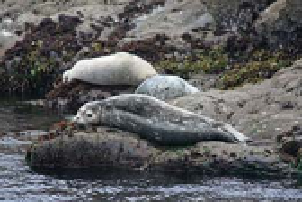Biology Reference
In-Depth Information
Harbor Seal
The Harbor Seal (
Phoca vitulina richardsi
) has shiny, nickel-grey fur with
an all-over peppering of darker spots. At roughly 300 pounds and six feet
long, males are the size of a big man, females slightly smaller. This plump,
relatively stubby seal finds the bay so comfortable that it lives here year-
round. Scientists say about 600 Harbor Seals can be counted among the
permanent residents of the estuary.
Harbor Seals dive and forage throughout the open waters of the bay,
especially around islands and isolated rocks where they haul out. Harbor
Seals must get out of the water almost daily to digest their food and rest.
Being relatively small, they are not as well insulated as other marine mam-
mals and must spend a fair amount of time basking in the sun to maintain
their body temperature.
For safety, Harbor Seals seek areas that offer long-distance views in
every direction and allow them to slip quickly into deep waters at the first
sign of danger. That's an uncommon combination in the noisy, developed
modern bay, but these seals use at least 20 shoreline spots on a regular
basis to rest in the estuary.
The bay's seal population has remained stable for decades. “They're un-
usually urbanized seals,” says National Park Service biologist Sarah Allen,
author of
Field Guide to Marine Mammals of the Pacific Coast
. “hey're
more tolerant of people than colonies along the coast. The seals on Castro
Rocks, for example, have the Richmond Bridge, with all sorts of vehicle
noise, over their heads and big oil tankers constantly going by. They've
learned these kinds of disturbances aren't really going to hurt them. If the
same tanker went by the seals on the Farallon Islands or Devil's Point, it
would flush the whole herd into the water.”
Harbor Seals may not be as imposing as sharks, but they certainly rank
among the bay's top predators. They rely on their sensitive and luxuriant
whiskers to find fish. By spreading their whiskers out they can detect min-
ute disturbances in the water: a fish swimming by or flapping its tail
changes the currents around it, creating what scientists call a hydrody-
namic trail (or “hydro-trail”). Even blindfolded, seals easily trail fish
around.
Harbor Seals can dive to depths of
nearly 350 feet and can reach speeds
of up to 12 miles per hour while pursu-
ing fish. (Max Eissler)


